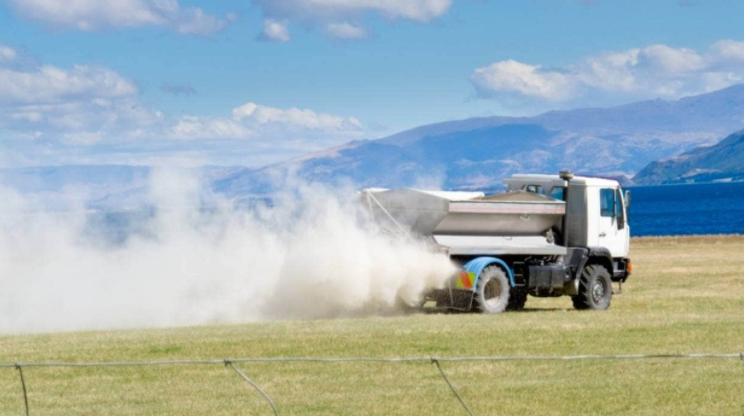Fertiliser application rates and timing
What
Managing the rate, timing and place of fertiliser application can have both cost and environmental benefits through reducing nitrate leaching in land with deep drainage. Although many nutrients that occur naturally in the soil and those added by fertiliser are taken up by plants, some excess remains in the soil and is vulnerable to loss.

Image source: Stuff
Why
In 2014, scientists from the International Plant Nutrition Institute (membership is made up of fertiliser companies) published the 4R Nutrient Stewardship Guidelines for best management practices for fertiliser use worldwide. Their suggested practice includes considering the four rights when applying fertiliser: Was the crop given the right type of nutrients at the right rate, time, and place?
Select the right type of fertiliser with the right nutrients for your farm
| Select the right rate of fertiliser application
|
Select the right time for fertiliser application
| Select the right place to apply the fertiliser
|
Professor Richard McDowell, Chief Scientist for Our Land and Water - National Science Challenge says “Managing fertiliser well isn’t expensive. Farmers can half the amount of phosphorus leaving their farm with minimal impact on farm profitability.”
Nutrient management is an important concept for ensuring efficient nutrient use and avoiding or minimising adverse environmental impacts. It combines production and environmental aspects of nutrient input and output management, rather than considering manufactured fertiliser use in isolation. Complete nutrient management looks more widely at all sources of nutrient input and output and considers manufactured fertiliser use as part of the mix. Good nutrient management will lead to good outcomes both the environmentally and economically.
Nutrient inputs (sources)
| Nutrient outputs (sinks)
|
Practices to reduce nitrate leaching when applying fertiliser
- Avoid direct leaching by not applying fertiliser to paddocks in winter or to waterlogged soils
- Test the soil to ensure other nutrients are not limiting for plant nutrient uptake
- Optimise response rate and pasture utilisation
- Use slow release fertilisers
Slow release fertilisers have particular benefits which include:
Nutrient release according to plant requirements
Optimal uptake of the applied nitrogen
Environmentally safe nitrogen fertilisation management
No ammonia releases
Minimal leaching
Uniform particle size enabling very consistent spreading
How the fertiliser is applied will also affect the accessibility of nutrients. Different application methods can determine whether the nutrient is either immediately available to rapidly growing plants or released very gradually over a lengthy growing period. Application will also affect the degree of interaction between the fertiliser and the soil, which is particularly important where nutrients can become unavailable due to reactions with soil minerals (e.g., phosphorus fixation) or organic matter (e.g., nitrogen immobilisation).
Common options for fertiliser application
Surface broadcast application (by ground or aerial spreading)
Surface broadcast and incorporated into the soil
Foliar application
Fine particle suspension or slurry application (ground or aerial)
The best application method will depend on the nutrient(s) concerned, topography and individual production situations. For example, applications to crops, especially in horticulture, generally require more accuracy and precision than applications to intensive pastures where nutrients are continually redistributed by the grazing animals.
Data shows that at a catchment scale reactive phosphate rock (RPR) can potentially decrease phosphorus in streams by up to 58% compared with superphosphate (McDowell et al., 2010). Other products, such as Serpentine Super, can also decrease losses by about 20–30% compared to superphosphate. It is important to note that data shows that products such as RPR only produce the same amount of pasture as superphosphate when soil pH is <6 and rainfall is >800 mm. When transitioning from superphosphate to RPR, it is best replace a third of the superphosphate with RPR each year: 33% RPR in year one, 66% RPR in year two, and 100% RPR in year three.
Industry Good Management Practice recommends having a nutrient management plan for your property. Read more about Nutrient Management Plans and what they include here.
References
Thomas, S. M., Ledgard, S. F., and Francis, G. S. (2005). Improving estimates of nitrate leaching for quantifying New Zealand’s indirect nitrous oxide emissions. Nutrient Cycling in Agroecosystems, 73(2-3), 213-226.Ministry for Primary Industries
Johnston, A. M., and Bruulsema, T. W. (2014). 4R nutrient stewardship for improved nutrient use efficiency. Procedia Engineering, 83, 365-370.
Nash, D. M., McDowell, R., Condron, L. M., and McLaughlin, M. J. (2019). Direct exports of phosphorus from fertilizers applied to grazed pastures. Journal of Environmental Quality, 48(5), 1380-1396. doi:10.2134/jeq2019.02.0085.